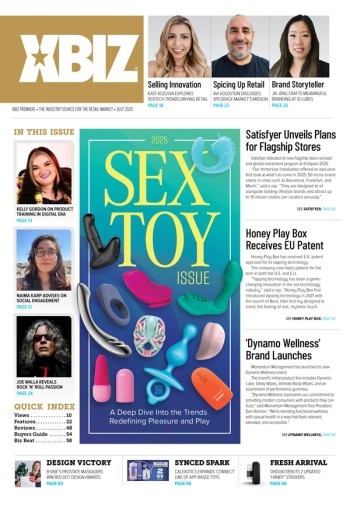It is a dream that many have shared: to publish online video content across all connected devices, with user control over the playback timeline, at a low cost, and using only a single delivery technology.
With the imminent rollout of the MPEG-DASH (Dynamic Adaptive Streaming over HTTP) system, it is time for XBIZ to take a closer look at what this technology may mean for online adult content producers; but as far as it being the utopian means of content delivery, the bottom line may be, “keep dreaming.”
MPEGDASH is an adaptive bit rate streaming technology that partitions multimedia files into one or more segments, delivering them to clients over HTTP.
According to Wikipedia, MPEGDASH is an adaptive bit rate streaming technology that partitions multimedia files into one or more segments, delivering them to clients over HTTP. A media presentation description (MPD) lists segment information, including timing and URL, along with media characteristics such as video resolution and bit rates. While segments can contain any media data type, MPEG-4 files or MPEG-2 Transport Streams are the preferred vehicles. Although MPEG-DASH is codec agnostic, it often involves deploying several versions of the same multimedia file, using different resolutions and bit rates; delivering the optimum selection based on network conditions, device capabilities and user preferences. It is essentially seeking to repackage your existing video content into a more user-friendly container.
Stating that there is “a need for an interoperable universal standard that can work on today’s Internet infrastructure and deliver a consistent high quality experience to the end user,” an overview from the Dash Promoters Group (www.dashpg.com/documents/DASHPGMPEG-DASH-Overview.pdf), outlines the project’s benefits, along with the reasons for its development.
Some of those benefits include the fact that MPEG-DASH is compatible with current technologies, allowing the use of existing audio and video codecs, plus digital rights management (DRM) solutions, among other infrastructure items. This could dramatically streamline the technology’s deployment into current production workflows that could profit from the benefits offered by MPEG-DASH.
As with any such technology, adoption and support by a handful of heavyweight players is required for any standardized video solution to gain traction; and while some of these companies have expressed tacit support for MPEG-DASH, they may be doing so at the peril of their bottom line.
For example, Adobe Dynamic Streaming and Apple HTTP Live Streaming (HLS) could be rendered moot by MPEG-DASH, causing these companies to pause in their support for any so-called standards. Although Microsoft Smooth Streaming could also be replaced by MPEG-DASH, the company says that it will support the new technology as soon as the standard is finalized — which is predicted for this year.
Another major obstacle is uncertainty over licensing fees, with Mozilla reportedly stating that it is unlikely to include support for MPEGDASH in its popular Firefox web browser unless it is totally fee-free — an issue that has caused problems for Adobe Flash, which has had to postpone licensing fee changes.
Perhaps more insurmountable for some operators, MPEG-DASH might hinder the rollout of HTML 5 (a true standard in web technology), as publishers may have to offer both H.264 and WebM versions of content in order to make use of MPEGDASH across all platforms. Microsoft among others is working on this problem, however. According to a company release, it is “contributing to W3C efforts to standardize adaptive streaming APIs in HTML 5 so that DASH Web applications may also be written in HTML 5 and ECMAScript (JavaScript) in the future without requiring browser plug-ins such as Silverlight and Flash to enable advanced streaming media scenarios.”
That is all fine and dandy, but it still leaves content producers and marketers with an alphabet soup of media formats and delivery types to contend with; and it is unlikely that any technology will become a one-size-fits-all solution to online video delivery. Not to sound cynical, but with online video expected to grow to more than 90 percent of Internet traffic over the next two years, its enabling systems will be far too lucrative for players to ignore — or for romantic notions of free Open Source solutions to hold sway.
As for the benefits to consumers, Microsoft says that MPEG-DASH “provides a framework to enable adaptive streaming appropriate for all types of devices, and further standardization of media formats and content protection can enable playback compatibility to provide universal access to Internet TV, movies, user generated video, education, communication, etc.”
You can read “Hollywood backed UltraViolet” into that statement about “further standardization.”
“[MPEG-DASH] has the potential to give publishers access to any consumer on any video device capable of Internet access,” Microsoft explains. “Rather than preparing several servers and sets of content to reach different types of devices, a publisher should eventually be able to publish in a single DASH Application Profile that can be played by all devices.”
Parsing that statement, however, reveals that MPEGDASH is a transitory technology, as it requires “several … sets of content,” in order for adaptive streaming to “adapt” — with “eventually” being the timeframe for the dream of a single source solution to online video delivery to be realized.
Patents and politics, rights and royalties play a role in the development and release of MPEG-DASH — with some of its backers being perhaps more interested in fighting Google and its Open Source VP8 than with pushing MPEG-DASH forward.





